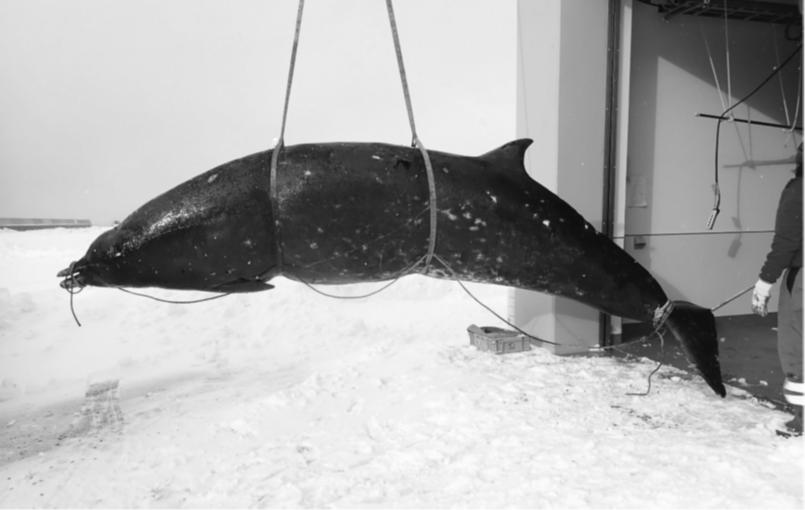A comprehensive investigation has revealed that the elusive ginkgo-toothed beaked whale, hitherto shrouded in mystery, inhabits a broader geographical range than previously perceived, venturing into the icy realms of the North Pacific.
Within the realm of cetaceans, a group encompassing fully aquatic creatures like whales, dolphins, and porpoises, the diversity is staggering, boasting over 90 distinct species. These are categorized into two main groups: baleen whales (Mysticeti) and toothed whales (Odontoceti). Among the toothed whales, characterized by their teeth, lies the lesser-known genus Mesoplodon. These enigmatic beings primarily dwell in the remote expanses of the offshore oceans, rarely gracing the surface with their presence, rendering their distribution and ecological habits a puzzle.
A dedicated team of researchers, featuring Assistant Professor Kuroda Mika from Hokkaido University’s Field Science Center for Northern Biosphere and Professor Matsuishi Takashi Fritz from the Faculty of Fisheries Sciences, recently unveiled a groundbreaking discovery—a stranded ginkgo-toothed beaked whale found on the shores of Yakumo, Southern Hokkaido. Their findings have been meticulously documented in the esteemed journal “Aquatic Mammals.”
Distinctive Traits of the Mesoplodon Genus
Kuroda elucidates, “The Mesoplodon genus comprises a diverse array of over 15 known species, constituting the largest genus within the Ziphiidae family. These species are discerned by the unique contours of their heads and the distinct characteristics of the males’ teeth. In the case of the ginkgo-toothed beaked whale, scientifically known as Mesoplodon ginkgodens, the males bear teeth that span 10 centimeters in width, resembling the leaves of the ginkgo tree, Ginkgo biloba.”
Our knowledge of ginkgo-toothed beaked whales has largely emanated from the examination of a meager 95 individuals discovered in 88 isolated instances of whale strandings. Notably, 30 of these strandings transpired in various locales across Japan.
On February 4, 2022, a report surfaced regarding a stranded whale in Yakumo town, Hokkaido. The carcass of the whale was conveyed to the Hakodate Research Centre for Fisheries and Oceans for meticulous examination and necropsy. Measuring a substantial 477 centimeters in body length, the male whale had already entered an advanced state of decomposition, signifying that it had met its demise some time ago. Its physical attributes concurred with the established characteristics of M. ginkgodens. Furthermore, a genetic analysis of mitochondrial DNA conclusively placed this specimen within the clade designated for M. ginkgodens, boasting an identical genetic sequence.
Expanded Geographic Scope of Strandings
Previous instances of stranded ginkgo-toothed beaked whales have been reported across an extensive spectrum of locations, including Japan, the US West Coast, Australia, the Galapagos Islands, Thailand, New Zealand, Micronesia, the Marshall Islands, China, South Korea, and Mexico. These occurrences have materialized in temperate, subtropical, and tropical waters. However, the current study marks the maiden observation of Mesoplodon ginkgodens in the frigid waters of the North Pacific.
Kuroda adds, “Another potential stranding event that could have involved a ginkgo-toothed beaked whale was reported on November 29, 2021, although the specimen was lost due to adverse weather conditions. Our findings strongly suggest that these whales might undertake migratory journeys near Hokkaido during the winter season.”
Reference: “Northernmost Record of the Ginkgo-Toothed Beaked Whale (Mesoplodon ginkgodens)” by Wojtek Bachara, Kuroda Mika, et al., July 9, 2023, in the esteemed journal “Aquatic Mammals.”
DOI: 10.1578/AM.49.4.2023.356
Table of Contents
Frequently Asked Questions (FAQs) about Ginkgo-Toothed Beaked Whale Discovery
What is the ginkgo-toothed beaked whale mentioned in the text?
The ginkgo-toothed beaked whale is a little-known species of whale belonging to the Mesoplodon genus. It is characterized by unique teeth that resemble the leaves of the ginkgo tree.
Where was the discovery of the ginkgo-toothed beaked whale made?
The discovery of the ginkgo-toothed beaked whale was made on the shores of Yakumo, Southern Hokkaido, in Japan.
How do researchers identify ginkgo-toothed beaked whales?
Researchers identify ginkgo-toothed beaked whales by examining the shape of their heads and specific teeth in males. These whales have distinctive teeth that are approximately 10 centimeters wide, resembling ginkgo leaves.
What is the significance of this discovery?
This discovery is significant as it expands the known geographical range of the ginkgo-toothed beaked whale into the cold waters of the North Pacific, a previously unreported habitat for this species.
How many known species are there in the Mesoplodon genus?
The Mesoplodon genus comprises over 15 known species, making it the largest genus within the Ziphiidae family.
What is the unique genetic feature that confirms the identity of the discovered specimen?
Genetic analysis of mitochondrial DNA confirmed the identity of the discovered specimen as a ginkgo-toothed beaked whale (Mesoplodon ginkgodens), as it shared an identical genetic sequence with this species.
Where have previous strandings of ginkgo-toothed beaked whales occurred?
Previous strandings of ginkgo-toothed beaked whales have been reported in various locations, including Japan, the US West Coast, Australia, the Galapagos Islands, Thailand, New Zealand, Micronesia, the Marshall Islands, China, South Korea, and Mexico. These strandings have occurred in temperate, subtropical, and tropical waters.
Do ginkgo-toothed beaked whales migrate near Hokkaido during a specific season?
The study suggests that ginkgo-toothed beaked whales may undertake migratory journeys near Hokkaido, particularly during the winter season.



5 comments
love reading bout whales! ginkgo-toothed beaked, quite a name!
ginkgo-toothed beaked whale’s a real puzzle! amazing it in colder North Pacific waters!
such cool species! mesoplodon genus, big deal! needed more info on DNA, tho
we’ve got ginkgo-toothed beaked whales in Hokkaido? cool! winters, they’re here?
ginkgo-toothed beaked whale, wow! 1st time in North Pacific, incredible discovery